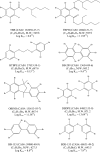Measurements of selected brominated flame retardants in nursing women: implications for human exposure
- PMID: 24992303
- PMCID: PMC4124063
- DOI: 10.1021/es5016839
Measurements of selected brominated flame retardants in nursing women: implications for human exposure
Abstract
We have examined several emerging brominated flame retardants (BFRs) including 2-ethyl-1-hexyl-2,3,4,5-tetrabromobenzoate (TBB), bis(2-ethylhexyl) tetrabromophthalate (TBPH), 1,2-bis(2,4,6-tribromophenoxy) ethane (BTBPE), 4,5,6,7-tetrabromo-1,1,3-trimethyl-3-(2,3,4,5-tetrabromophenyl)-indane (OBIND), and decabromodiphenyl ethane (DBDPE) in paired human maternal serum (n = 102) and breast milk (n = 105) collected in 2008-2009 in the Sherbrooke region in Canada. Three legacy BFRs were also included in the study for comparison: decabromobiphenyl (BB-209), 2,2',4,4',5,5'-hexabromobiphenyl (BB-153), and 2,2',4,4',5,5'-hexabromodiphenyl ethers (BDE-153). TBB, BB-153, and BDE-153 had detection frequencies greater than 55% in both serum and milk samples. Their lipid weight (lw) adjusted median concentrations (ng g(-1) lw) in serum and milk were 1.6 and 0.41 for TBB, 0.48 and 0.31 for BB-153, and 1.5 and 4.4 for BDE-153, respectively. The detection frequencies for the other BFRs measured in serum and milk were 16.7% and 32.4% for TBPH, 3.9% and 0.0% for BTBPE, 2.0% and 0.0% for BB-209, 9.8% and 1.0% for OBIND, and 5.9% and 8.6% for DBDPE. The ratio of TBB over the sum of TBB and TBPH (fTBB) in serum (0.23) was lower than that in milk (0.46), indicating TBB has a larger tendency than TBPH to be redistributed from blood to milk. Overall, these data confirm the presence of non-PBDE BFRs in humans, and the need to better understand their sources, routes of exposure, and potential human health effects.
Figures


References
-
- Shaw S. D.; Blum A.; Weber R.; Kannan K.; Rich D.; Lucas D.; Koshland C. P.; Dobraca D.; Hanson S.; Birnbaum L. S. Halogenated flame retardants: Do the fire safety benefits justify the risks?. Rev. Environ. Health 2010, 254261–305. - PubMed
-
- Costa L. G.; Giordano G.; Tagliaferri S.; Caglieri A.; Mutti A. Polybrominated diphenyl ether (PBDE) flame retardants: Environmental contamination, human body burden and potential adverse health effects. Acta Bio Med. Atenei Parmensis 2008, 793172–183. - PubMed
-
- Ma Y.; Venier M.; Hites R. A. 2-Ethylhexyl tetrabromobenzoate and bis(2-ethylhexyl) tetrabromophthalate flame retardants in the Great Lakes atmosphere. Environ. Sci. Technol. 2012, 461204–208. - PubMed
-
- Zhou S. N.; Reiner E. J.; Marvin C.; Helm P.; Riddell N.; Dorman F.; Misselwitz M.; Shen L.; Crozier P.; MacPherson K.; Brindle I. D. Development of liquid chromatography atmospheric pressure chemical ionization tandem mass spectrometry for analysis of halogenated flame retardants in wastewater. Anal. Bioanal. Chem. 2010, 39631311–1320. - PubMed
-
- Zhou S. N.; Reiner E. J.; Marvin C. H.; Helm P. A.; Shen L.; Brindle I. D. Liquid chromatography/atmospheric pressure photoionization tandem mass spectrometry for analysis of Dechloranes. Rapid Commun. Mass Spectrom.. 2011, 253436–442. - PubMed
Publication types
MeSH terms
Substances
Grants and funding
LinkOut - more resources
Full Text Sources
Other Literature Sources
Medical
Miscellaneous

